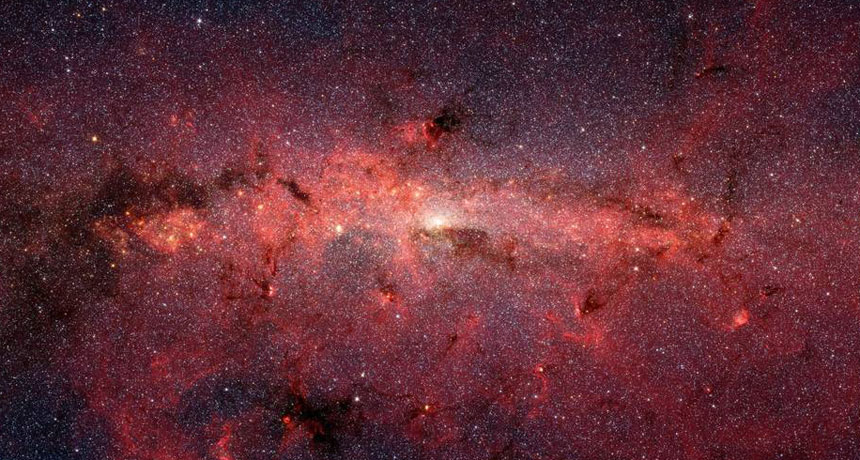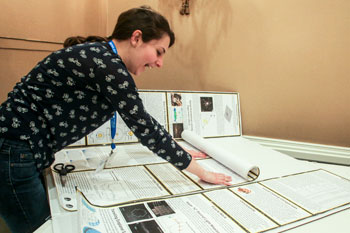Teen hunts exoplanets at our galaxy’s center
A young astronomer combs through data to find new worlds

The center of our galaxy is full of stars. A teen wanted to find out if there were any planets in the mix.
Susan Stolovy (SSC/Caltech) et al/JPL-Caltech/NASA
WASHINGTON, D.C. — Some scientists look for new planets by gazing through powerful telescopes. But Claire Burch, 17, didn’t have one of those. Instead, the senior at Mira Loma High School in Sacramento, Calif., searched for new exoplanets — planets outside our solar system. All she needed was her laptop and some computer code. If her results are right, she may have found 17 stars host unknown worlds.
Claire presented her results at the Intel Science Talent Search. Run by Society for Science & the Public and sponsored by Intel Corporation, the event brings together 40 high school students each year. Here, they have been sharing their science projects with the public and competing for cash awards totaling more than $1 million.
“A lot of people have these stories of loving space all their lives. I’m not one of those,” Claire admits. She learned to love space in eighth grade. That’s when she participated in a Science Olympiad event called “Reach for the Stars.” In it, students competed in a variety of events related to astronomy. She then got to do her own research at the Summer Science Program in Socorro, N.M. There, Claire studied near-Earth asteroids and learned how to write computer code in a language called Python.
The summer before her senior year, Claire again applied her knowledge of computer coding to her love of astronomy. She decided to work with data from the Optical Gravitational Lensing Experiment, a project based at the University of Warsaw in Poland. With gravitational lensing, astronomers can glimpse the light from distant objects in space because it has been magnified by the gravity of something large, like a black hole.
Scientists usually have used the Optical Gravitational Lensing Experiment to try to detect dark matter — a mysterious substance that emits no light or other radiation. Data from the experiment are free to use, though, for this or any other type of space studies. Many of those data describe light coming from the center of our galaxy, the Milky Way. This area, called the galactic bulge, is tightly packed with stars.
Claire applied some code to these data to detect exoplanets. She didn’t expect to find many. The stars in the galactic bulge are very, very old, and formed when there wasn’t a lot of heavy metal elements around — the kind that would form the biggest planets.
The teen took two algorithms — or series of steps to solve a problem — and translated them into Python code. She then used the code to analyze data from the lensing experiment.

Once the teen had signals from her first algorithm, she applied a second one known as Box-fitting least squares. This algorithm would determine if the dip in brightness was steep enough and long enough to likely be caused by a planet orbiting in front of its star.
After applying these two algorithms to the lensing data, Claire found 17 stars that may host planets. It’s not many, but the teen admits. “It’s like the smallest number that would be reasonable,” she explains. “If I had fewer, it’d be discouraging but believable. If I had more, it’d be unlikely. [It would mean there] might be a problem with the research.”
But, Claire notes, this is just the first step. “I wouldn’t say I’ve discovered a planet,” she says. “This is just something I did for fun, to see if I could do it.” The dips she detected with her code could be due to other things, including random fluctuations in star brightness. She hopes, though, that other studies will confirm that she really did find exoplanets.
And if they really are planets, Claire hopes that they are massive gas giants. Some scientists call these “puffy planets.” If she finds one, the teen says, she’d like to name it “Fluffy.”
Follow Eureka! Lab on Twitter
Power Words
(for more about Power Words, click here)
algorithm A group of rules or procedures for solving a problem in a series of steps. Algorithms are used in mathematics and in computer programs for figuring out solutions.
asteroid A rocky object in orbit around the sun. Most orbit in a region that falls between the orbits of Mars and Jupiter. Astronomers refer to this region as the asteroid belt.
astronomy The area of science that deals with celestial objects, space and the physical universe. People who work in this field are called astronomers.
black hole A region of space having a gravitational field so intense that no matter or radiation (including light) can escape.
code (in computing) To use special language to write or revise a program that makes a computer do something.
coding A slang term for developing computer programming — or software — that performs a particular, desired computational task.
dark matter Physical objects or particles that emit no detectable radiation of their own. They are believed to exist because of unexplained gravitational forces that they appear to exert on other, visible astronomical objects.
element (in chemistry)Each of more than one hundred substances for which the smallest unit of each is a single atom. Examples include hydrogen, oxygen, carbon, lithium and uranium.
exoplanet A planet that orbits a star outside the solar system. Also called an extrasolar planet.
galactic bulge A densely packed group of stars within a larger formation of stars known as a galaxy.
galaxy A massive group of stars bound together by gravity. Galaxies, which each typically include between 10 million and 100 trillion stars, also include clouds of gas, dust and the remnants of exploded stars.
gas giant A giant planet that is made mostly of the gases helium and hydrogen. Jupiter and Saturn are gas giants.
gravitational lensing The distortion of light by an intense gravitational force, such as what can be exerted by clusters of galaxies — the most massive things in the universe. The gravity can bend or focus light, making it appear brighter and in one or more different places in the sky.
gravity The force that attracts anything with mass, or bulk, toward any other thing with mass. The more mass that something has, the greater its gravity.
Intel Science Talent Search An annual competition created and run by Society for Science & the Public and sponsored by Intel Corp. Begun in 1950, this event brings 40 research-oriented high school seniors to Washington, D.C. to showcase their research to the public and to compete for awards.
Milky Way The galaxy in which Earth’s solar system resides.
orbit The curved path of a celestial object or spacecraft around a star, planet or moon. One complete circuit around a celestial body.
planet A celestial object that orbits a star, is big enough for gravity to have squashed it into a roundish ball and it must have cleared other objects out of the way in its orbital neighborhood. To accomplish the third feat, it must be big enough to pull neighboring objects into the planet itself or to sling-shot them around the planet and off into outer space. Astronomers of the International Astronomical Union (IAU) created this three-part scientific definition of a planet in August 2006 to determine Pluto’s status. Based on that definition, IAU ruled that Pluto did not qualify. The solar system now includes eight planets: Mercury, Venus, Earth, Mars, Jupiter, Saturn, Uranus and Neptune.
radiation (in physics) One of the three major ways that energy is transferred. (The other two are conduction and convection.) In radiation, electromagnetic waves carry energy from one place to another. Unlike conduction and convection, which need material to help transfer the energy, radiation can transfer energy across empty space.
Society for Science and the Public (or SSP) A nonprofit organization created in 1921 and based in Washington, D.C. Since its founding, SSP has been not only promoting public engagement in scientific research but also the public understanding of science. It created and continues to run three renowned science competitions: The Intel Science Talent Search (begun in 1942), the Intel International Science and Engineering Fair (initially launched in 1950) and Broadcom MASTERS (created in 2010). SSP also publishes award-winning journalism: in Science News (launched in 1922) and Science News for Students (created in 2003). Those magazines also host a series of blogs (including Eureka! Lab).
solar system The eight major planets and their moons in orbit around the sun, together with smaller bodies in the form of dwarf planets, asteroids, meteoroids and comets.
star The basic building block from which galaxies are made. Stars develop when gravity compacts clouds of gas. When they become dense enough to sustain nuclear-fusion reactions, stars will emit light and sometimes other forms of electromagnetic radiation. The sun is our closest star.
telescope Usually a light-collecting instrument that makes distant objects appear nearer through the use of lenses or a combination of curved mirrors and lenses. Some, however, collect radio emissions (energy from a different portion of the electromagnetic spectrum) through a network of antennas.